10 Key Insights on 2nd Party Data for Market Analysts

10 Key Insights on 2nd Party Data for Market Analysts
Overview
The article "10 Key Insights on 2nd Party Data for Market Analysts" emphasizes the importance and application of second-party data in market analysis. Second-party data, which consists of first-party information shared between organizations, presents unique features that enhance marketing strategies and targeting capabilities. By leveraging this data, market analysts can gain a competitive edge, allowing for more precise audience segmentation and tailored marketing efforts.
Moreover, the article underscores the value of ethical practices and partnerships in maximizing the effectiveness of second-party data. Establishing trustworthy relationships between organizations not only fosters collaboration but also ensures that data is used responsibly, thereby enhancing its value in decision-making processes. How can your organization benefit from these ethical partnerships?
In conclusion, understanding the role of second-party data is crucial for market analysts aiming to refine their strategies. By embracing these insights, professionals can enhance their decision-making capabilities, ultimately leading to more effective marketing outcomes. The implications are clear: ethical use of shared data is not just beneficial, but essential for success in today’s data-driven landscape.
Introduction
The landscape of market analysis is rapidly evolving, with second-party data emerging as a critical asset for professionals seeking deeper insights. This unique type of information, sourced from trusted partners, allows analysts to enhance their understanding of consumer behavior and refine marketing strategies. As the demand for reliable data grows, however, so do the challenges associated with its integration and compliance.
How can market analysts navigate these complexities to fully harness the power of second-party data? By addressing these questions, professionals can stay ahead in a competitive environment, ensuring they leverage this valuable resource effectively.
Initial Data Offering: Access Unique Second-Party Data Datasets
The Initial Data Offering (IDO) serves as a centralized hub for accessing unique 2nd party data information datasets. This platform utilizes 2nd party data to link information providers with prospective purchasers, significantly enhancing the visibility and accessibility of valuable collections across various domains, such as finance, social media, and environmental studies. Analysts can delve into high-quality datasets that are specifically tailored to meet distinct market needs. This capability empowers informed decision-making and strategic planning. Furthermore, with fresh datasets available daily, enrolling in the Initial Data Offering provides exclusive access to premium information. This ensures that market research professionals stay ahead in their data-driven strategies.
What does this mean for your work? The IDO not only offers a wealth of data but also equips you with the tools necessary to leverage that data effectively. By utilizing these datasets, you can enhance your analytical capabilities and make more informed decisions. As the landscape of data continues to evolve, staying updated with the latest offerings becomes crucial for maintaining a competitive edge in your field.
In summary, the IDO presents a valuable resource for professionals seeking to harness the power of data. By providing access to tailored datasets, it enables users to navigate complex market dynamics with confidence and precision.
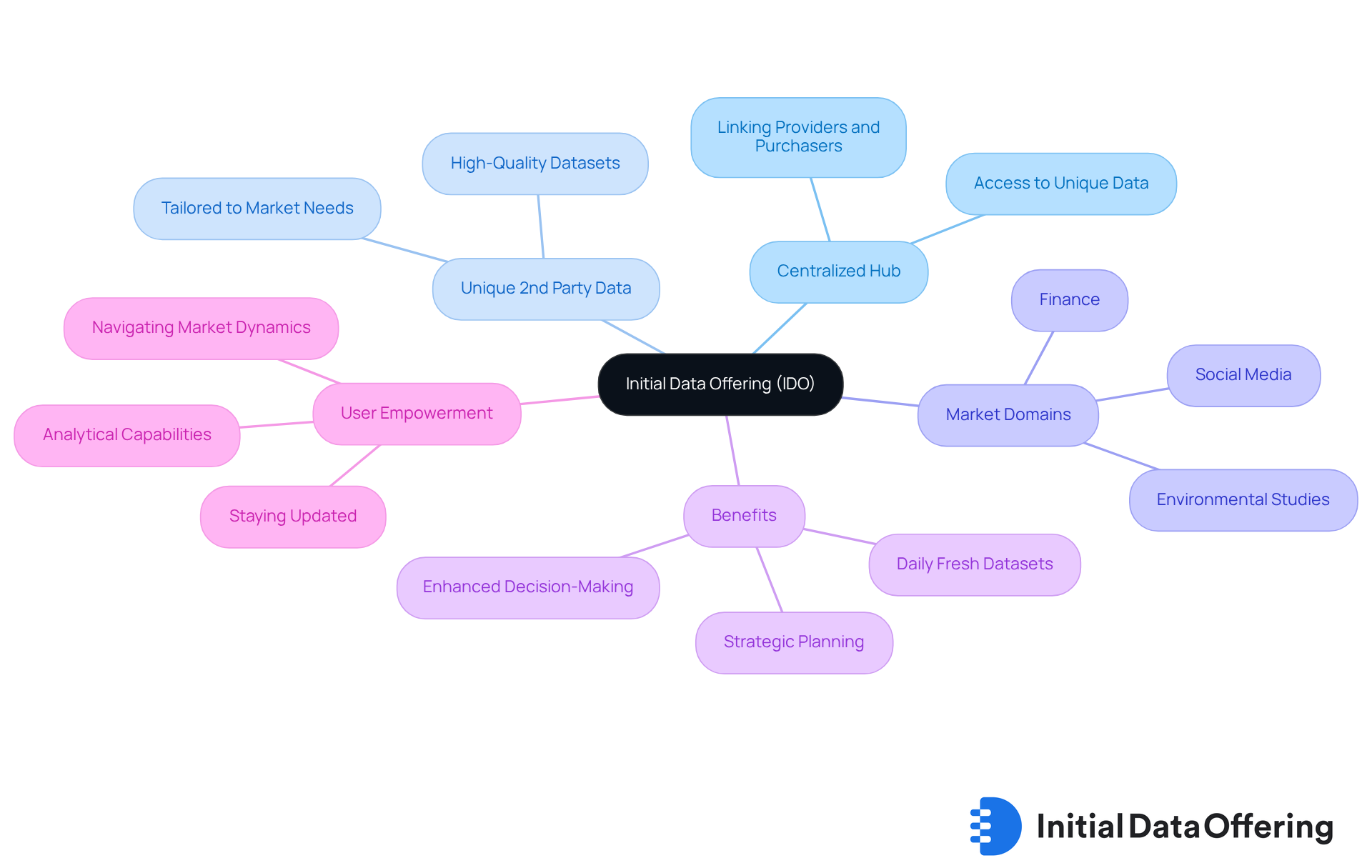
Understanding Second-Party Data: Definition and Importance
Second-party information is defined as first-party information sourced from another organization, shared through formal partnerships. This type of information is particularly valuable because it provides insights from a reliable source, enabling analysts to develop a deeper understanding of consumer behavior and market dynamics. The significance of external information lies in its ability to enhance marketing strategies, refine targeting, and offer a more comprehensive perspective of the market landscape.
Current trends indicate that organizations are increasingly leveraging 2nd party data to bolster their marketing efforts. For instance, businesses are forming strategic partnerships to exchange customer insights, which allows them to engage new audience segments while maintaining information integrity. This collaborative approach not only broadens the information pool but also fosters trust among partners, leading to more effective marketing campaigns. As Roberta Johnston states, "The exchange of shared information involves a mutual understanding or contractual arrangement between two parties," underscoring the importance of trust in these partnerships.
Market analysts emphasize the value of reliable information sources, noting that secondary information is often perceived as having superior quality and precision compared to third-party information. By utilizing external information, companies can craft more tailored marketing strategies that resonate with their target audiences. For example, a hotel reservation site might share its client information with an airline booking service, enabling both entities to enhance their offerings based on a combined understanding, ultimately improving targeting capabilities and fostering greater engagement.
Real-world examples illustrate the effectiveness of second-party information in generating consumer insights. Companies that have successfully implemented strategies using 2nd party data report enhanced targeting abilities and increased ROI. By understanding customer preferences through shared information, organizations can personalize their marketing messages and product offerings, leading to improved engagement and higher conversion rates.
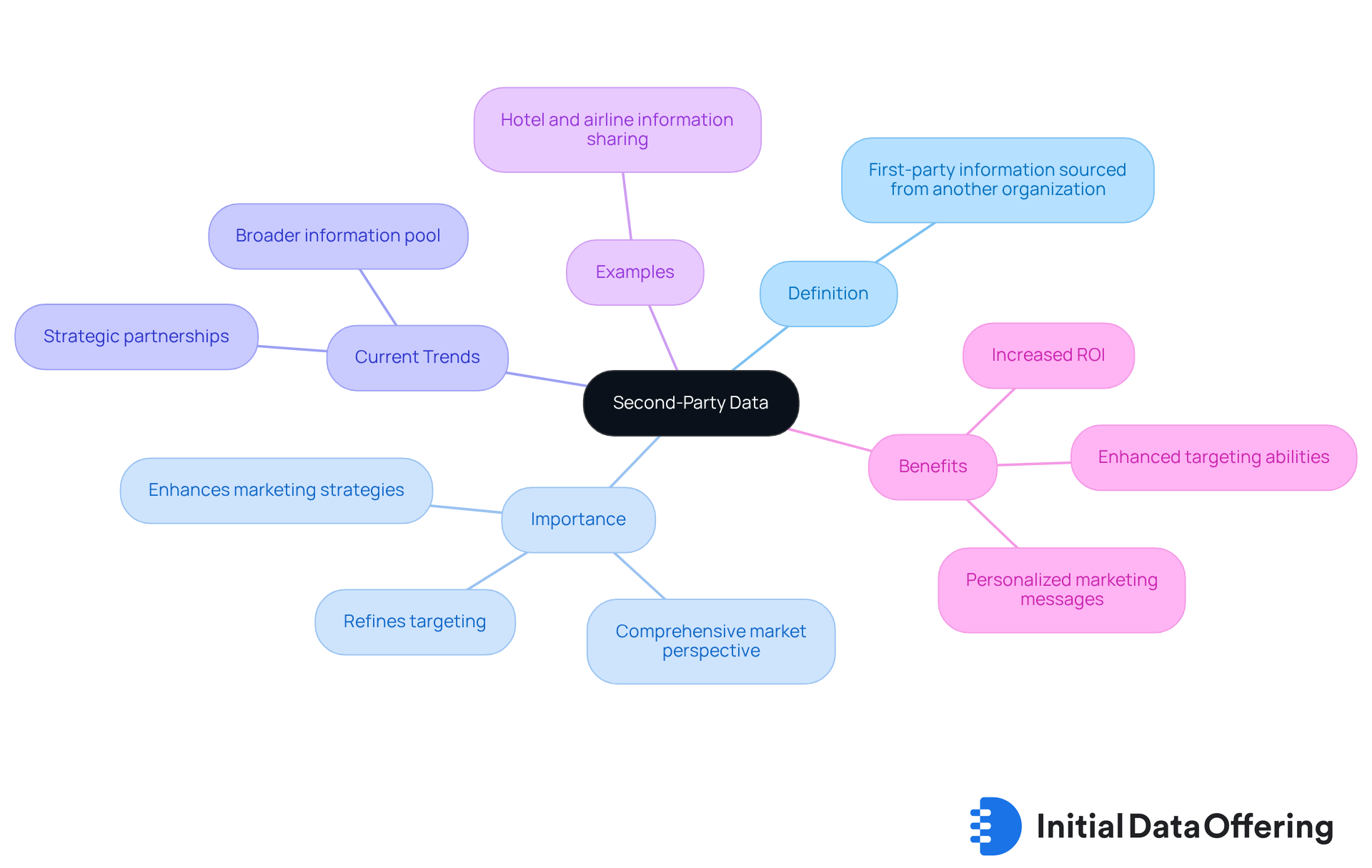
First-Party vs. Second-Party Data: Key Differences Explained
First-party information is collected directly from a company's own customers through interactions on its platforms, such as websites and mobile applications. This information is proprietary and provides high reliability due to its direct collection method. In contrast, information from a partner organization represents another company's first-party insights shared through collaboration, enabling organizations to access additional knowledge via 2nd party data without the requirement for direct collection. This cooperative aspect of external information can improve targeting abilities and expand audience reach.
Understanding the reliability of these information sources is crucial for market analysts. First-party information is frequently regarded as the gold standard because of its precision and relevance, whereas second-hand information can offer valuable perspectives from reliable collaborators. For instance, organizations such as media publishers providing information to advertisers and grocery stores exchanging loyalty information often engage in partnerships to share insights that can enhance marketing strategies.
As of 2025, approximately 61% of companies are utilizing first-party information, while 39% are leveraging 2nd party data. A substantial segment of marketers (61.9%) is concentrating on first-party information strategies in anticipation of a cookieless future. This trend highlights the increasing significance of source reliability in shaping effective marketing approaches and decision-making processes. Analysts must consider these distinctions to ensure they are extracting understanding from the most dependable and relevant information sources available.
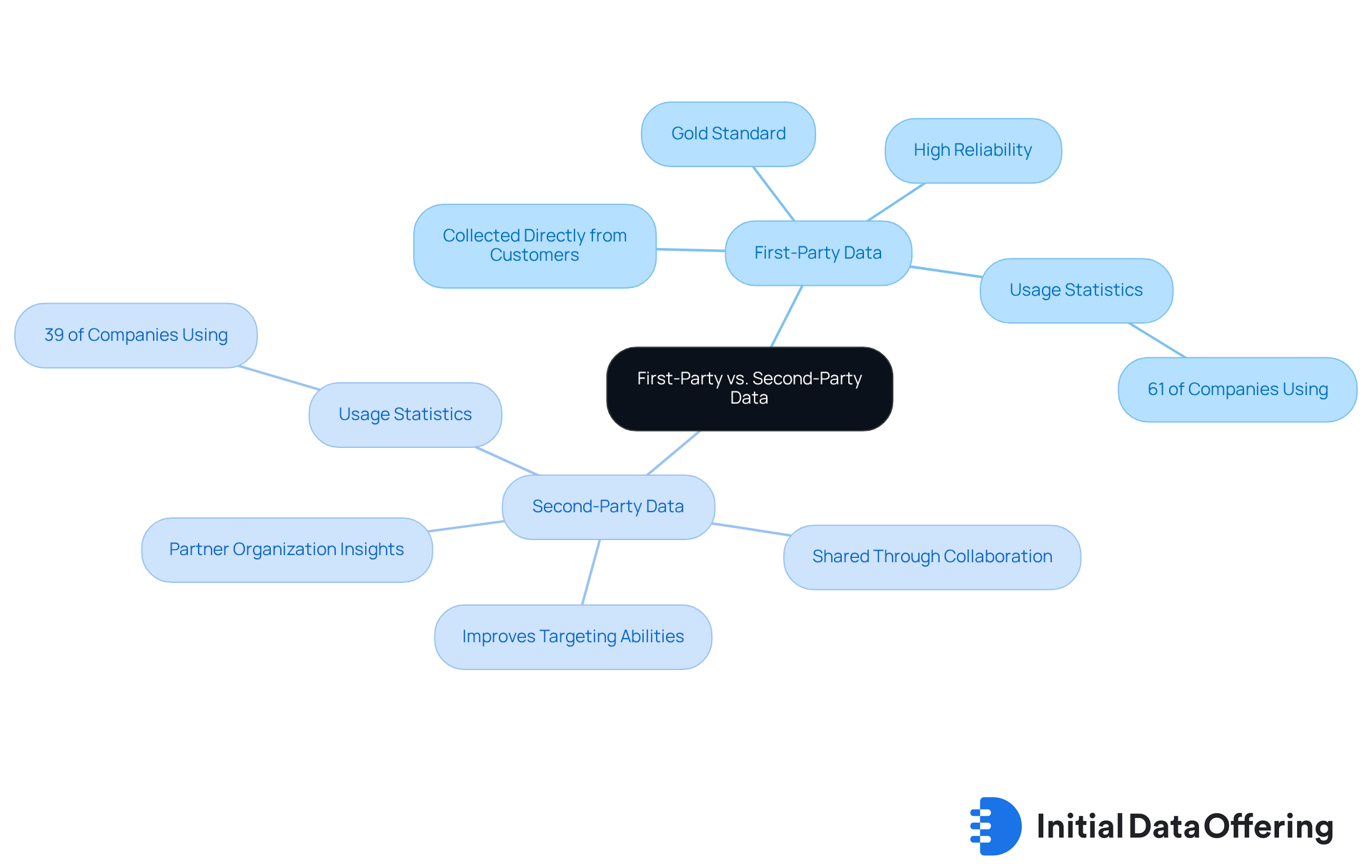
Benefits of Second-Party Data: Enhancing Market Research Insights
2nd party data presents notable features that significantly enhance market research. It offers enriched audience insights, improved targeting capabilities, and access to new customer segments by utilizing 2nd party data. These advantages enable analysts to deepen their understanding of consumer behavior, refine marketing strategies, and achieve better business outcomes. For instance, e-commerce platforms often utilize 2nd party data by sharing customer purchase histories with retail partners, a collaborative approach that fosters more accurate targeting and personalized marketing efforts. This method not only enhances audience comprehension but also encourages innovative marketing solutions, ultimately boosting engagement and conversion rates.
Moreover, analysts recognize that while second-party information is a valuable resource, it should complement other insights rather than serve as the sole basis for decision-making. This broader perspective enhances targeting efficiency. As organizations increasingly prioritize information privacy and transparency, building trustworthy relationships with partners becomes crucial. This ensures compliance with regulations such as GDPR and CCPA while maximizing the value derived from shared insights.
How can your organization leverage second-party information to enhance its marketing strategies? By considering these insights, businesses can position themselves to navigate the complexities of consumer engagement effectively.
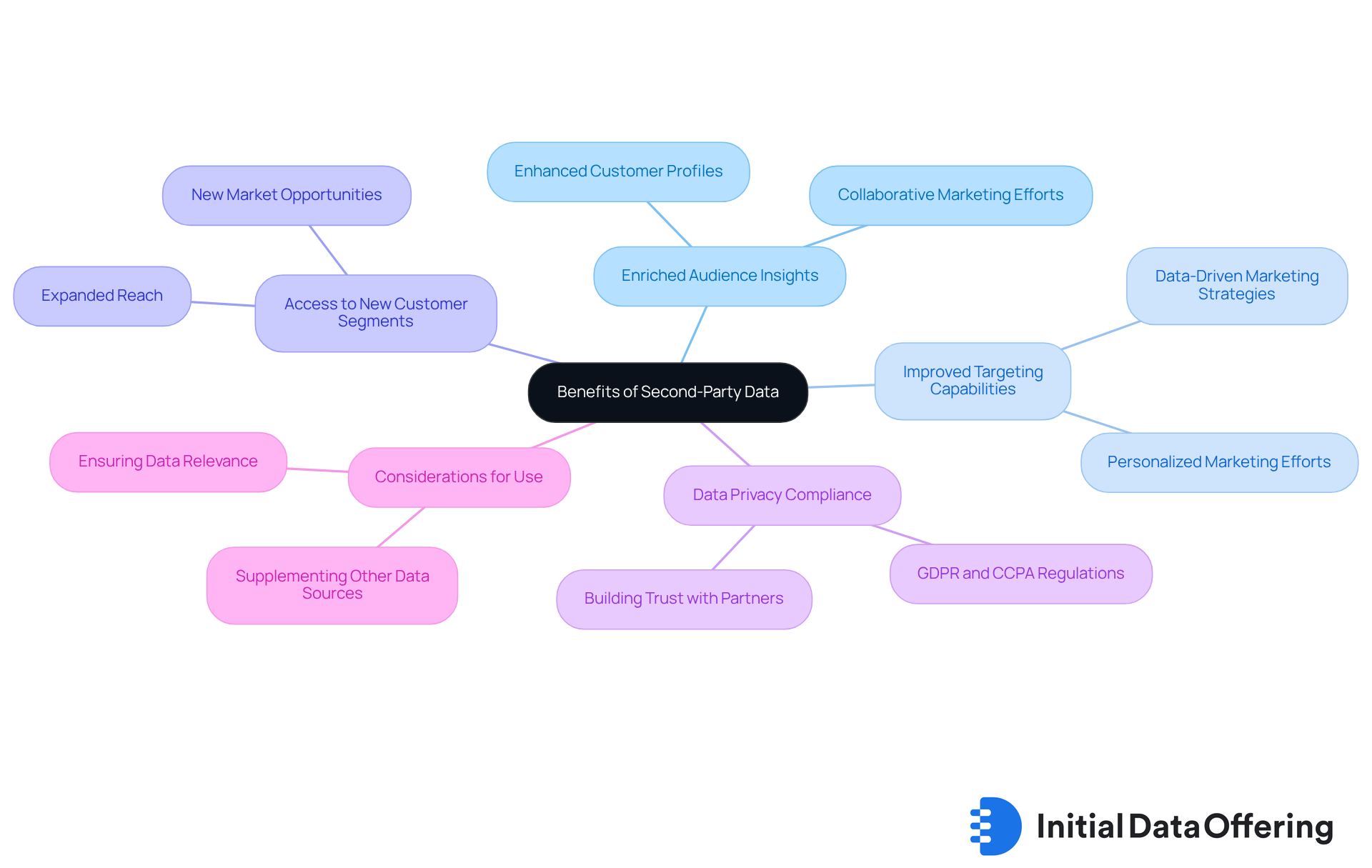
Challenges of Second-Party Data: What Market Analysts Should Know
2nd party data provides substantial benefits, yet it also presents various challenges that researchers must navigate. Key issues include:
- Integration difficulties
- Compliance with evolving privacy regulations
- Potential discrepancies in information quality
For instance, a notable statistic reveals that 41% of analysts express low confidence in marketing information due to inconsistencies. Furthermore, 53% of respondents who encountered manual information handling reported a low level of trust in their figures because of inaccuracies. This underscores the importance of ensuring information accuracy when relying on external sources.
Organizations frequently face challenges in aligning their practices with privacy regulations. Compliance experts emphasize the necessity of conducting regular audits to uphold legal standards. Tom Wilkinson highlights that companies must ensure that external information adheres to privacy laws and regulations to avoid penalties for GDPR violations. Additionally, reliance on external information can limit control and ownership over the data.
Thus, it is essential for researchers to develop robust strategies that incorporate 2nd party data to address these challenges. By understanding these complexities, market specialists can more effectively leverage secondary information while mitigating associated risks.
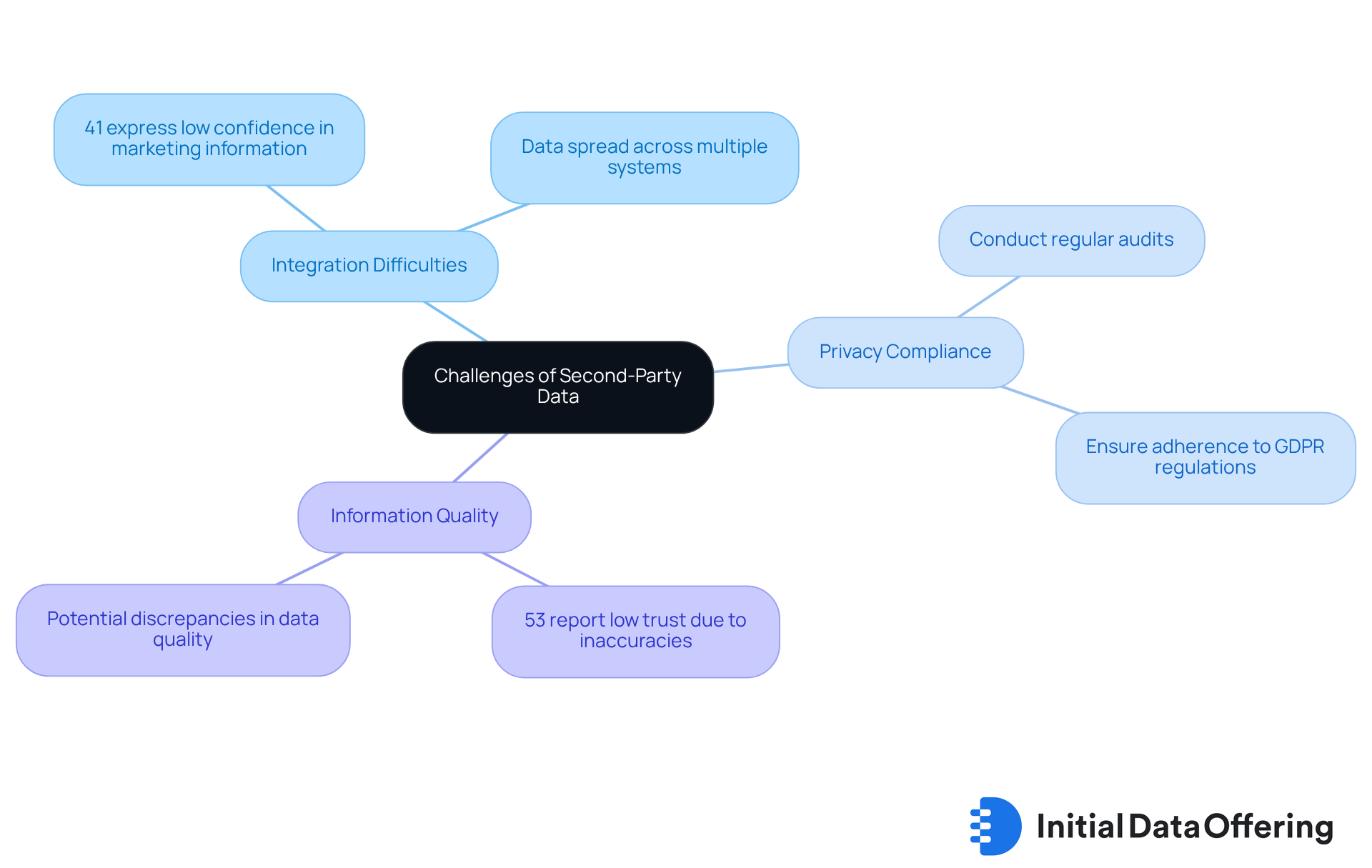
Leveraging Data Partnerships: Maximizing Second-Party Data Value
To fully harness the potential of second-party information, market analysts should prioritize establishing strong partnerships. Collaborating with organizations that target similar audiences yields deeper insights and significantly enhances marketing strategies. Companies engaging in successful partnerships report a 27% increase in revenue compared to their competitors, underscoring the financial benefits of collaboration. Furthermore, 70% of firms believe that collaborations are crucial for their development and achievement, emphasizing the significance of partnerships in a broader context.
By leveraging these partnerships, analysts gain access to unique datasets, such as 2nd party data, that enrich their research capabilities and foster innovation in marketing efforts. This approach not only improves targeting accuracy but also enhances audience understanding, leading to more personalized and effective marketing campaigns. Additionally, organizations that align their goals and share a strategic vision experience a 50% higher success rate in partnerships, reinforcing the value of collaboration.
Integrating external information into marketing strategies enables companies to optimize their efforts, minimize waste, and enhance return on investment (ROI). As industry leaders emphasize, the integration of 2nd party data from trusted partners can unlock new levels of customer engagement and drive better results in today's competitive landscape. Consequently, market experts should proactively pursue and nurture these collaborations to enhance the value obtained from external information. It is also vital to establish strong security frameworks to safeguard shared information and uphold trust, as 84% of executives indicate that trust is the main factor in selecting a partner. However, analysts must remain aware of potential risks associated with external information, such as accuracy and compliance concerns, to ensure effective and responsible collaboration.
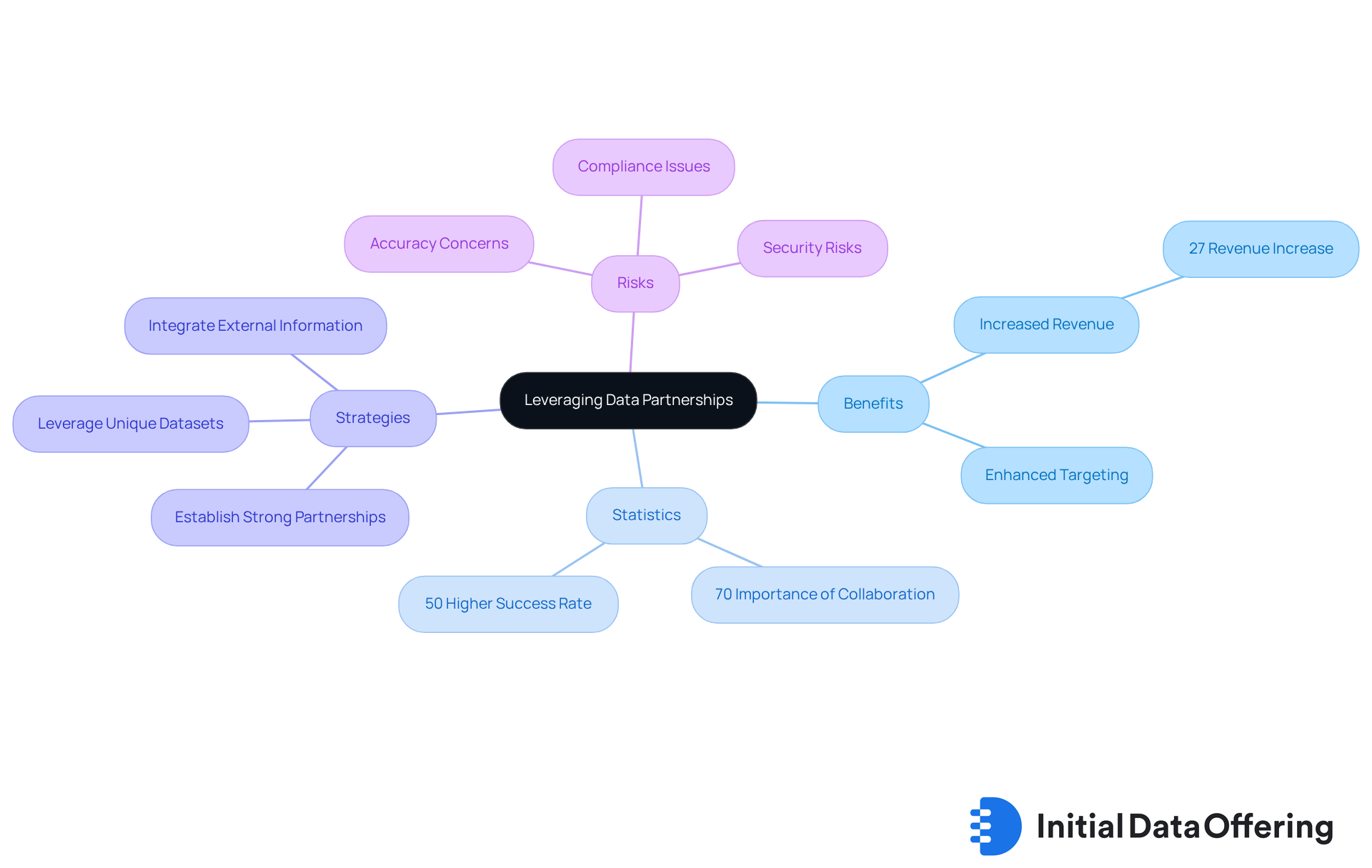
Technology's Role in Accessing Second-Party Data: Tools and Techniques
Technology plays a crucial role in accessing and utilizing third-party information. Analysts can leverage information management platforms, analytics tools, and integration software to streamline the process of obtaining and analyzing external data. For instance, SavvyIQ's AI-powered Recursive Data Engine offers access to a dynamic graph of 265 million global entities. This capability not only enhances real-time decision-making but also automates workflows, making the process more efficient.
Furthermore, implementing methods like clean rooms for information and secure sharing protocols can significantly improve privacy and compliance. These strategies ensure that professionals handle third-party information responsibly and effectively. By employing advanced entity resolution and information APIs, market researchers can elevate their intelligence capabilities, leading to more informed decisions and strategic insights.
How can these tools and methods transform your approach to data analysis? By understanding the features and advantages of these technologies, professionals can harness their full potential, enhancing their operational effectiveness and driving better outcomes.
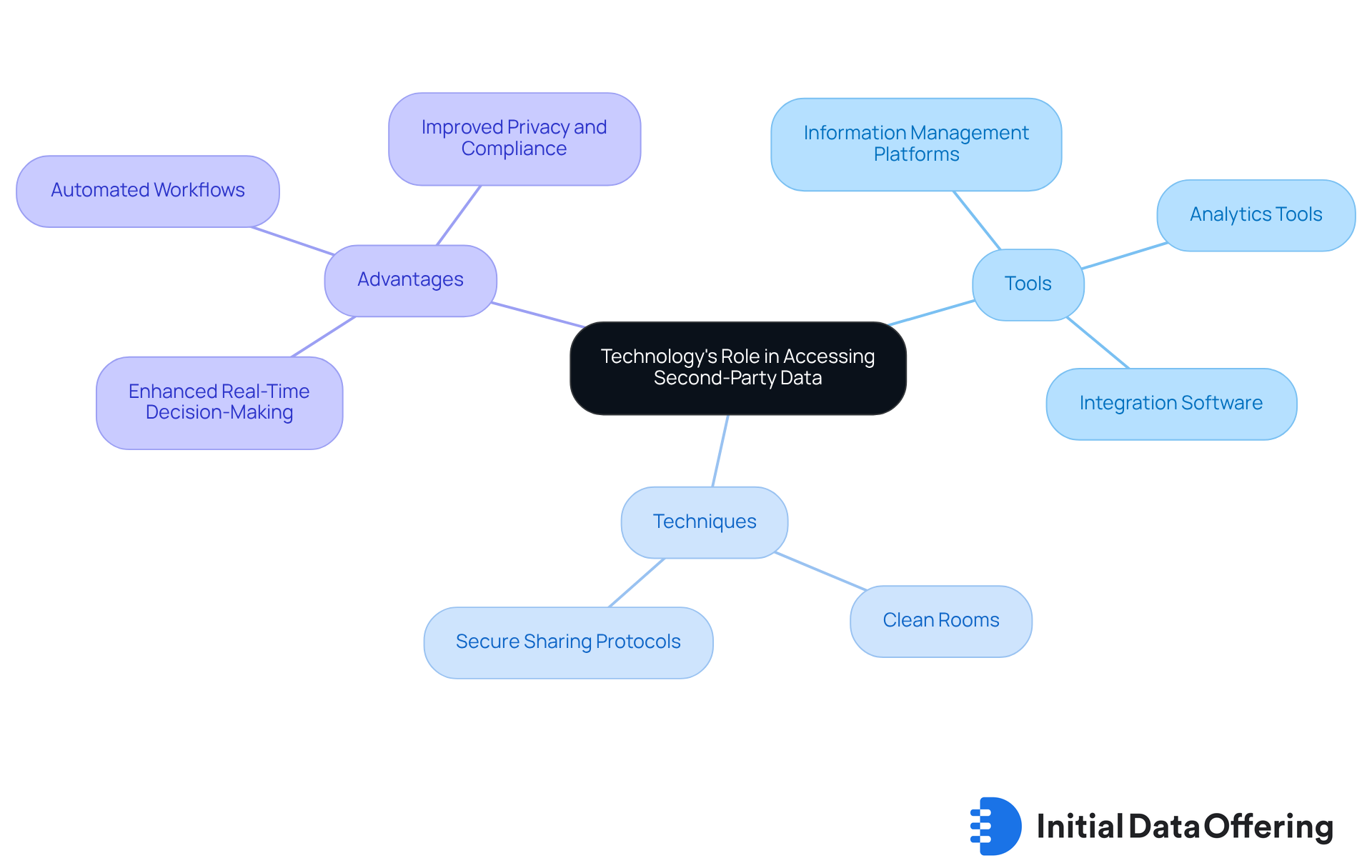
Ethical Considerations in Using Second-Party Data: Best Practices
When utilizing 2nd party data, market analysts must prioritize ethical considerations and adhere to best practices. This involves:
- Ensuring transparency in information usage
- Obtaining explicit consent from subjects
- Complying with relevant privacy regulations such as GDPR and CCPA
A notable 94% of organizations believe clients would cease engaging with them if their information isn't safeguarded. This statistic emphasizes the essential nature of safeguarding information in preserving trust. Furthermore, analysts should concentrate on information security and integrity, as 84% of consumers show increased loyalty to companies with strong security measures.
By adhering to these ethical guidelines, analysts can utilize 2nd party data responsibly, fostering trust with consumers and partners while enhancing the effectiveness of their market research efforts. Organizations like Countly exemplify best practices by providing adaptable tracking solutions that ensure compliance and protect user privacy.
As Countly's CEO emphasizes, Ensure your consent notices are clear regarding what information is collected and for what purpose. Additionally, it is crucial to honor choices; for example, if someone opts out of tracking, it is imperative to truly stop tracking. This commitment to ethical information usage is essential in today's evolving regulatory landscape.
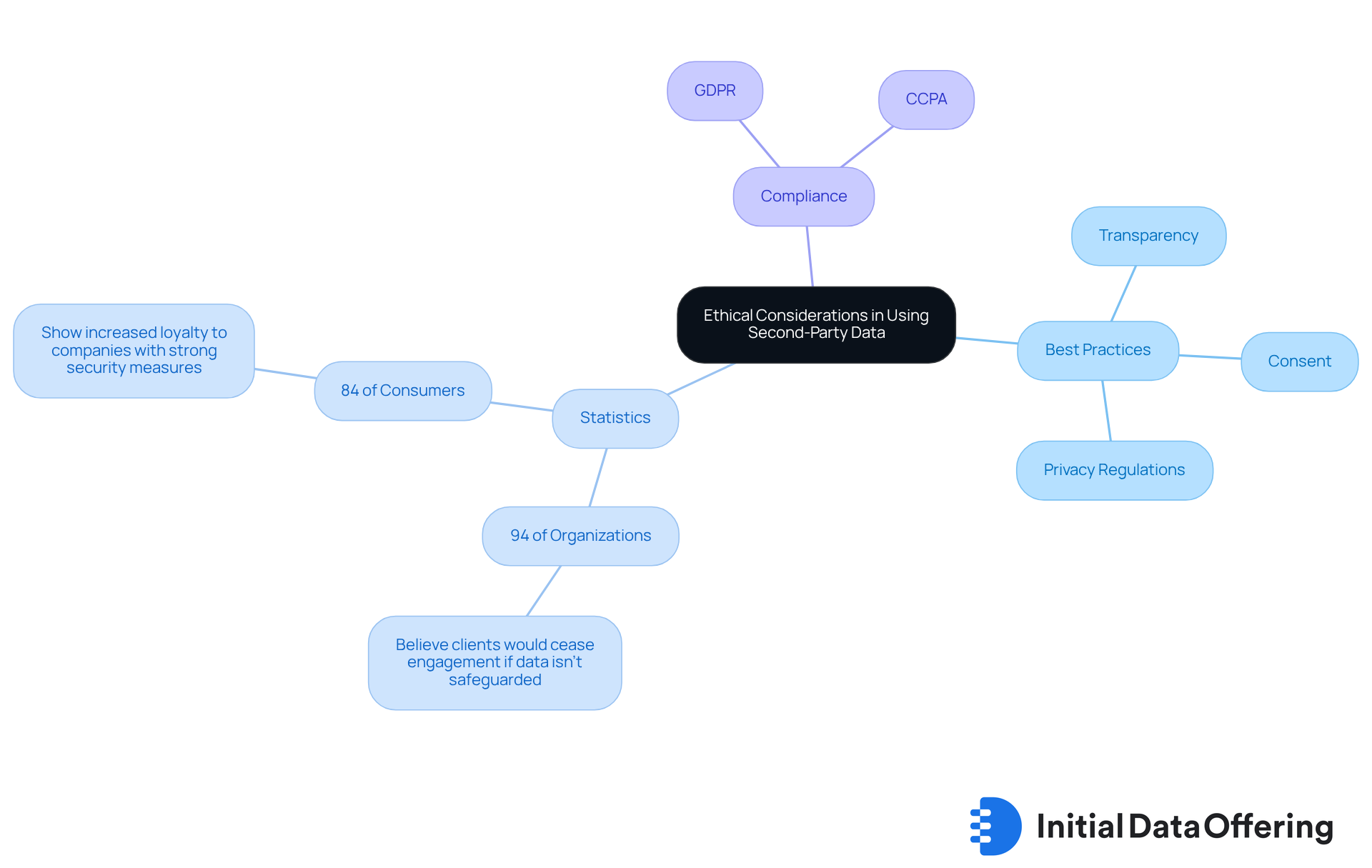
Future Trends in Second-Party Data: What to Expect
The evolving information landscape is marked by several significant trends in 2nd party data insights. Organizations are increasingly adopting clean rooms, which serve as secure environments for sharing information while ensuring compliance with privacy regulations. This shift is underscored by the fact that 66% of organizations are now utilizing clean rooms in some capacity, reflecting a growing recognition of their importance in facilitating secure collaborations. Analysts can expect that these clean rooms will not only enhance information sharing but also drive innovation in analysis, as they allow for the integration of various datasets without compromising individual privacy.
Technological advancements are pivotal in this transformation. As companies invest in robust integration tools, they simplify the process of analyzing 2nd party data, which leads to more actionable insights. The integration of AI and machine learning technologies is particularly significant, as these tools can uncover purchasing trends and improve customer engagement. Indeed, companies leveraging clean rooms have reported an average increase of 10-15% in customer engagement, underscoring the tangible benefits of this approach.
Industry analysts express optimism about the future of information clean rooms, with 63% of CMOs identifying them as a top investment for enhancing customer relationships and information management strategies. As organizations navigate the complexities of information privacy regulations and work towards compliance, the focus on secure sharing will only grow stronger. This trend positions clean rooms as essential elements in the marketing strategies of 2025 and beyond, empowering businesses to fully leverage alternative information while maintaining trust with their customers.
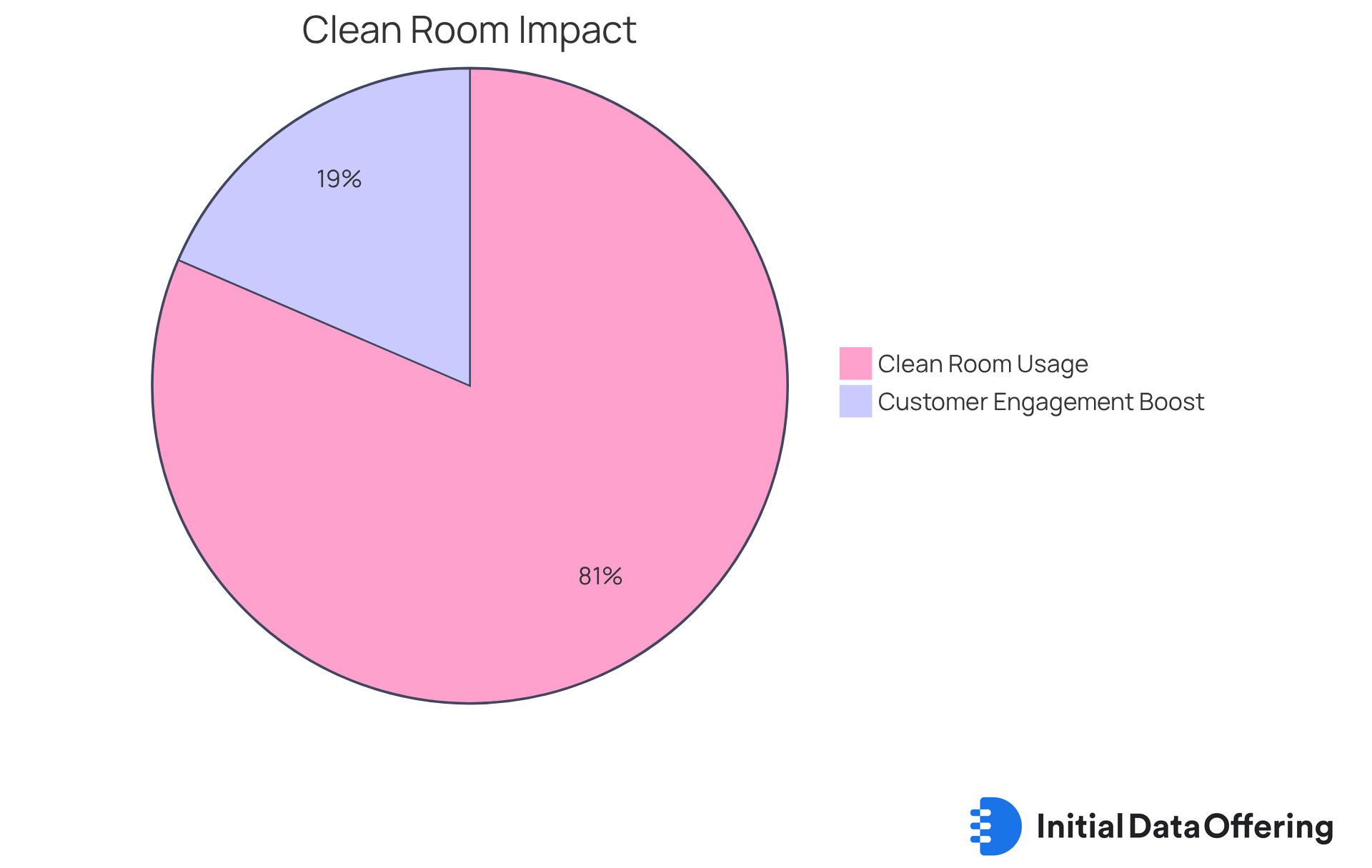
Actionable Strategies for Utilizing Second-Party Data Effectively
To utilize 2nd party data effectively, market analysts should adopt several actionable strategies.
- Establishing clear data-sharing agreements with partners is essential. This defines roles and responsibilities, ensuring that all parties understand their contributions.
- Investing in technology that enables information integration and analysis is crucial. This allows for seamless data flow and comprehensive insights.
- Continuously overseeing information quality and adherence guarantees trustworthy conclusions, which are vital for informed decision-making.
- Leveraging the insights gained from 2nd party data can significantly inform marketing strategies and drive business growth.
How can your organization implement these strategies to enhance its data utilization? By focusing on these areas, analysts can unlock the full potential of 2nd party data.
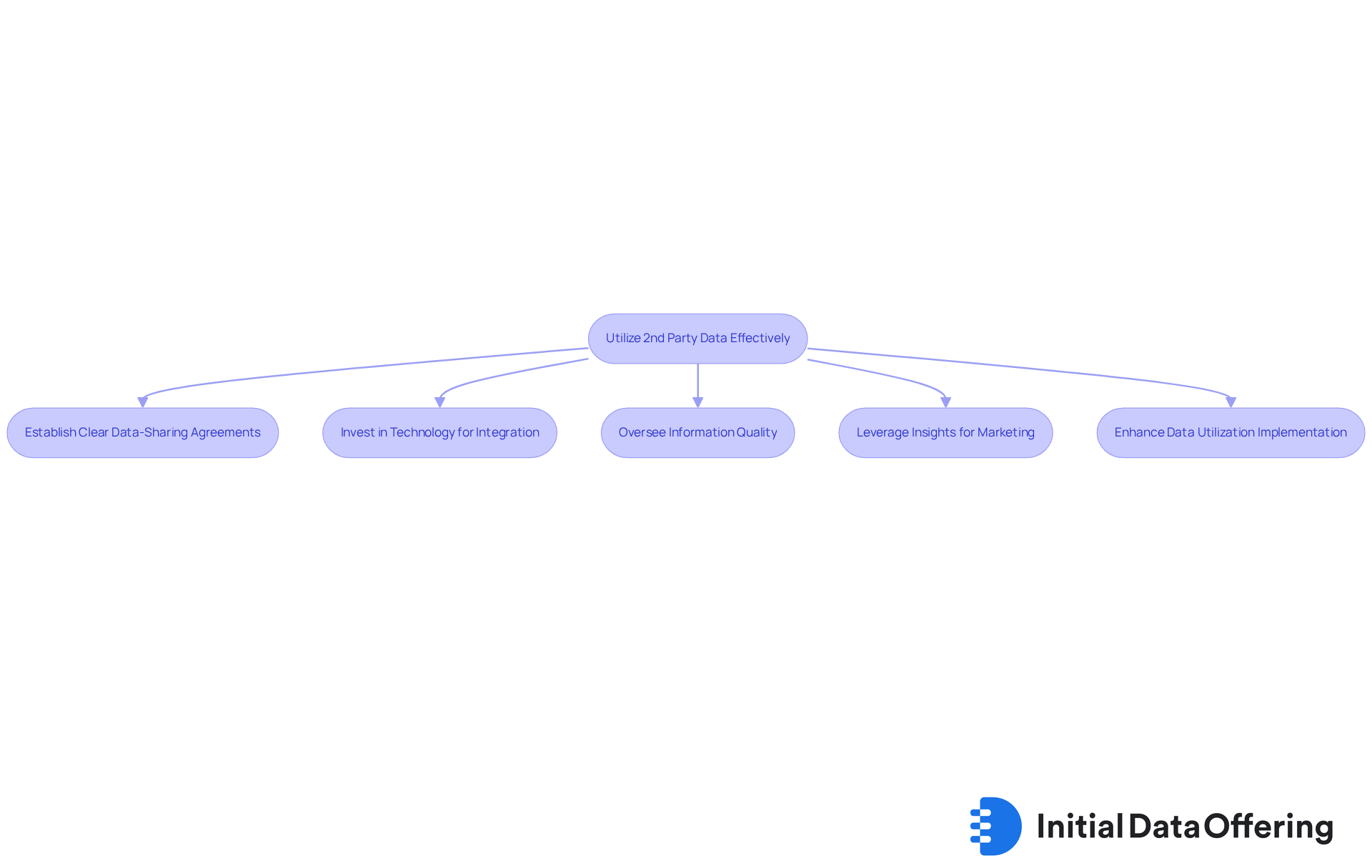
Conclusion
The insights into second-party data presented in this article underscore its increasing significance for market analysts navigating a complex data landscape. By comprehending and utilizing second-party information, professionals can enhance their analytical capabilities, refine their marketing strategies, and ultimately drive improved business outcomes. This distinctive form of data not only delivers valuable consumer insights but also cultivates partnerships that can result in more effective marketing campaigns.
Key arguments explored throughout the article emphasize:
- The definition and importance of second-party data
- The distinctions between first-party and second-party information
- The advantages it offers for market research
Additionally, challenges such as:
- Compliance with privacy regulations
- The necessity for robust data integration strategies
were addressed, highlighting the need for analysts to remain vigilant in their approach to data utilization. Furthermore, the role of technology and ethical considerations in managing second-party data were discussed, reinforcing the notion that responsible usage is crucial for building trust with consumers and partners alike.
As the data landscape continues to evolve, the actionable strategies outlined provide a roadmap for maximizing the value derived from second-party data. By prioritizing ethical practices, establishing strong partnerships, and investing in the right technologies, market analysts can unlock new levels of customer engagement and insight. Embracing these trends and strategies will not only enhance individual marketing efforts but also contribute to a more informed and data-driven industry moving forward.
Frequently Asked Questions
What is the Initial Data Offering (IDO)?
The Initial Data Offering (IDO) is a centralized hub for accessing unique second-party data information datasets, linking information providers with prospective purchasers to enhance visibility and accessibility of valuable collections across various domains.
What types of data can be accessed through the IDO?
The IDO provides access to second-party data across various domains, including finance, social media, and environmental studies.
How does second-party data differ from first-party data?
Second-party data is first-party information sourced from another organization and shared through formal partnerships, while first-party data is collected directly from a company's own customers through its platforms.
Why is second-party data important?
Second-party data is valuable because it provides insights from reliable sources, enhancing marketing strategies, refining targeting, and offering a comprehensive perspective of the market landscape.
How are organizations using second-party data?
Organizations are forming strategic partnerships to exchange customer insights, which allows them to engage new audience segments while maintaining information integrity, resulting in more effective marketing campaigns.
What are the benefits of using second-party data for marketing?
Utilizing second-party data can improve targeting abilities, enhance engagement with target audiences, and lead to increased ROI by personalizing marketing messages and product offerings.
What is the current trend regarding the use of first-party and second-party data?
As of 2025, approximately 61% of companies are utilizing first-party information, while 39% are leveraging second-party data, indicating a growing emphasis on source reliability in marketing strategies.
How does the reliability of first-party data compare to second-party data?
First-party data is often regarded as the gold standard due to its precision and relevance, while second-party data can provide valuable perspectives from reliable collaborators, enhancing overall marketing strategies.
What tools does the IDO provide to users?
The IDO equips users with the tools necessary to leverage the datasets effectively, enhancing their analytical capabilities and enabling more informed decision-making.
How often are new datasets available through the IDO?
Fresh datasets are available daily through the Initial Data Offering, ensuring users have access to the latest information.